You can organize your own Evita Tour when you visit Buenos Aires by locating each place on a map, then deciding what you want to visit, either on foot, by bus, by subway or by taxi.
If you decide to visit Los Toldos, the town of Evita’s childhood, Junín, where she was a young teenager, or the country house at San Vicente, the quinta where she and Perón relaxed on weekends, you can reach these places by car, bus, or train.
 Historian Santiago Regolo will give you an excellent tour of the Museum in English and Professor Pablo Vasquez, the Museum’s librarian, is also one of the city’s foremost experts on Argentine history and politics. Historian Santiago Regolo will give you an excellent tour of the Museum in English and Professor Pablo Vasquez, the Museum’s librarian, is also one of the city’s foremost experts on Argentine history and politics.
Today the Museo Evita offers visitors a pleasant restaurant with indoor and outdoor tables and a gift shop with tasteful but reasonably priced souvenirs.
Evita Museum
Lafinur 2988
Phone number (5411) 4807 0306
info@museoevita.org
Tues.-Sun. (11AM-7PM) | Library Mon-Fri 2-6 PM

Tip for visitors with more time: Visit Puerto Madero.
Once a docks storage area, Puerto Madero has undergone gentrification and become ultra chic. It is worth a
visit for its outdoor cafes, its restaurants, shopping, ecological reserve and its ships.
 This beautiful home began as a rich family’s palace. The Fundación Eva Perón acquired and renovated the “palacio” in 1948, then converted it into a home for women at risk, mostly single mothers and their children. As with most of Evita’s works, its life ended with the 1955 military coup. In 2000, the building took on a new life as the Museo Evita.
This beautiful home began as a rich family’s palace. The Fundación Eva Perón acquired and renovated the “palacio” in 1948, then converted it into a home for women at risk, mostly single mothers and their children. As with most of Evita’s works, its life ended with the 1955 military coup. In 2000, the building took on a new life as the Museo Evita.
As curator Gabriel Miramont explains, “Evita wanted a welcoming place for single mothers and women at risk. She did not want the coldness of an institution but a place where their were curtains at the windows and tablecloths on the tables.” She wanted the three Hogares de Tránsito to offer not only a roof and food but spiritual sustenance with a small chapel for prayer.
Curator Miremont hopes that people will not come “just to see objects but to understand a message as well.”
See “Temporary Homes”
• La Confederación General de Trabajo (la CGT) / Azopardo 802
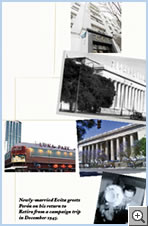 Perón and Evita often visited the CGT, union headquarters. Evita’s body was embalmed here and remained until the military removed it in 1955, mutilated it and hid it in Italy. Perón and Evita often visited the CGT, union headquarters. Evita’s body was embalmed here and remained until the military removed it in 1955, mutilated it and hid it in Italy.
• Luna Park / Corrientes y Leandro N. Alem
On January 22, 1944, Evita captivated Perón when they met in Luna Park during a fund-raising campaign for the victims of the San Juan earthquake.
They left Luna Park as a couple.
• Retiro Train Station
Evita’s brother Juan (in Buenos Aires for military service) was waiting for her when she arrived here in the summer of January 1935, to begin her acting career.

Avenida de Mayo starts in Plaza de Mayo and ends at the Plaza de Congreso where you will find Rodinís Thinker.
The Plaza de Mayo is the center of Argentine history with its Cathedral, Casa Rosada, the Government House, Cabildo and Pyramid.
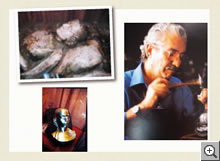 Visit the studio of Juan Carlos Pallarols at Defensa 1039. The Pallarols have been silversmiths for generations. Visit the studio of Juan Carlos Pallarols at Defensa 1039. The Pallarols have been silversmiths for generations.
Carlos Pallarols, Juan Carlos’ father, made the silver covering for Evita’s casket-and was forced to destroy it (see evitaperon.org). Juan Carlos makes the Presidential cane for each inauguration and has made objects for everyone from Bill Clinton to Nelson Mandela, including a silver chalice for a Pope.
• La Casa Rosada - "The Pink House"
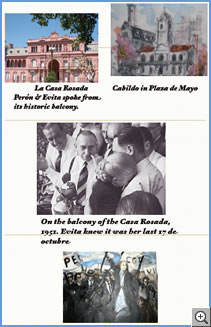 A “Peronista Day” was always sunny. The two most important holidays were May 1st, dedicated to the workers, and October 17th, Loyalty Day. Thousands came to commemorate October 17, 1945, when the workers’ demonstrations forced the military to release Perón from his prison on Martín García Island. A “Peronista Day” was always sunny. The two most important holidays were May 1st, dedicated to the workers, and October 17th, Loyalty Day. Thousands came to commemorate October 17, 1945, when the workers’ demonstrations forced the military to release Perón from his prison on Martín García Island.
Colonel Perón was taken from the island to the Military Hospital, then that night to Plaza de Mayo for his famous speech.
• The Cabildo
Built in 1764, the Cabildo was the center of Spanish power in Buenos Aires. On a rainy May 25, 1810, Argentines opened their umbrellas outside the Cabildo and declared their independence from Napoleonic Spain. This was Argentina’s first “Cabildo Abierto”. Its second Cabildo Abierto was on August 22, 1951, when hundreds of thousands of people begged Evita to confirm the Presidential ticket “Perón-Perón.”

To the left of the Casa Rosada, identifiable by its clock tower, is the building where Evita poured out her life to serve her descamisados.
Located on the corners of Perú and Diagonal Sur, it is now the “Edificio de la Legislatura Porteña” (the people of Buenos Aires are known as porteños-people of the port).
• Secretaría de Trabajo
 As the head of the Secretariat of Work and Social Security since 1943, Colonel Perón transformed the lives of his working class followers. Elevated to Ministry during Perón’s government, the elegant STP witnessed the countless hours Evita dedicated to her special loves, those who fell through the safety net-the poor, women at risk and their children, the sick-and her beloved workers. Perón told Evita to work from the Secretaría after the office she had been using in the Communications Ministry became too small. As the head of the Secretariat of Work and Social Security since 1943, Colonel Perón transformed the lives of his working class followers. Elevated to Ministry during Perón’s government, the elegant STP witnessed the countless hours Evita dedicated to her special loves, those who fell through the safety net-the poor, women at risk and their children, the sick-and her beloved workers. Perón told Evita to work from the Secretaría after the office she had been using in the Communications Ministry became too small.
• Audiences with Evita
Evita attended everyone and she was never in a hurry. Babies wailed, needing to be changed and fed, sodiapers and bottles were made available.
Evita drank water but never ate and often went home in a taxi after the last of the visitors had left in her car.
• What did you forget?
A young woman with small children and no husband came to ask Evita for a place to live. Evita gave her a house and sewing machine so she could work from her home, then asked, “Is that all?” and the woman answered yes. Evita told her to go sit down and think because she needed something else. Later, Evita questioned her again, but the woman had no answer. Evita said, “You still need teeth. You are too young to be without teeth.”
 • Hogar de la Empleada • Hogar de la Empleada
Built to help women employees make the transition from small town to large city, the Women’s Home had everything from a sun roof to a beauty parlor.
People flocked to its restaurant, famous for delicious and inexpensive food. Evita often dined there (in the early hours of the morning), enjoying the camaraderie with her staff and friends during the “Peña Eva Perón.” Fermín Chavez remembers, “The Evita I knew was joyful, spontaneous; she impressed you with her vitality [and] extraordinary memory.”

Congress, the Colón Opera House, the Ministry of Public Works and the Cervantes Theater “Life is a stage and men and women are merely players.”.
 The widest avenue in the world was the scene of Argentina’s second Cabildo Abierto, celebrated on August 22, 1951. Hundreds of thousands from all over the country gathered to convince Evita that she should be Argentina’s next Vice President. But Evita knew that powerful opponents in the military, the Church and the oligarchy opposed her. None of them were willing to accept a woman as vice president and possible commander-in-chief. In a remarkable dialogue, the people chanted, “Accept, Evita, accept! Now, Evita, now!’ Finally, Evita seemed to accept. “I will do as the people wish,” she said, yet her voice was tinged with sadness. On August 29, she renounced the honor the people had wished to bestow on her. “I will remain simply Evita,” she stated. She had decided that whatever time remained to her would be spent with the powerless, not with the powerbrokers. The widest avenue in the world was the scene of Argentina’s second Cabildo Abierto, celebrated on August 22, 1951. Hundreds of thousands from all over the country gathered to convince Evita that she should be Argentina’s next Vice President. But Evita knew that powerful opponents in the military, the Church and the oligarchy opposed her. None of them were willing to accept a woman as vice president and possible commander-in-chief. In a remarkable dialogue, the people chanted, “Accept, Evita, accept! Now, Evita, now!’ Finally, Evita seemed to accept. “I will do as the people wish,” she said, yet her voice was tinged with sadness. On August 29, she renounced the honor the people had wished to bestow on her. “I will remain simply Evita,” she stated. She had decided that whatever time remained to her would be spent with the powerless, not with the powerbrokers.
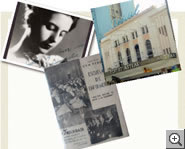 • Teatro Astral/ Corrientes 1639 On January 5, 1938 Evita was on stage here with Camilla Quiroga’s troupe in the play “Love in Algeria”. • Teatro Astral/ Corrientes 1639 On January 5, 1938 Evita was on stage here with Camilla Quiroga’s troupe in the play “Love in Algeria”.
• Ríobamba 478 Evita lived here in 1939.
• Escuela de Enfermeras / Nurses’ School / Callao 1218 Evita’s nurses studied here until the Policlínico Presidente Perón opened in the working class neighborhood of Avellaneda. Then they lived, studied and worked there.
Evita had cancer surgery at the Policlínico and voted for the first (and last) time from her hospital bed.
• Teatro Colón, located between Cerrito, Viamonte, Tucumán & Libertad
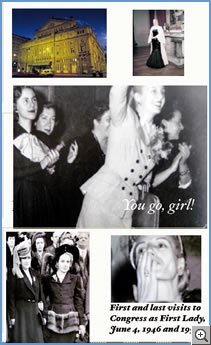 Inaugurated on May 25, 1908, the Colón Opera House is one of the best theaters in the world. If you see a picture of Evita in a formal gown, she was probably on her way to celebrate one of Argentina’s Independence Days, either on May 25 (from Napoleon’s Spain in 1810) or on July 9 (from the Spanish Monarchy in 1816). Inaugurated on May 25, 1908, the Colón Opera House is one of the best theaters in the world. If you see a picture of Evita in a formal gown, she was probably on her way to celebrate one of Argentina’s Independence Days, either on May 25 (from Napoleon’s Spain in 1810) or on July 9 (from the Spanish Monarchy in 1816).
• Teatro Cervantes / Corrientes & Libertad
Exactly three years to the day before her death, Evita celebrates organizing the Peronista Women’s Party. After women were given the right to vote in 1947, Evita wanted an independent party for the Peronista women. Since they were new to politics, she did not want them intimidated by the men. Women voted for Perón in overwhelming numbers in the 1951 Presidential elections. They would have liked to have voted for Evita, too.
• Congreso, at the end of Avenida de Mayo
The neoclassical Congress building dates from 1906. Over 8,000 people work there and its library is famous. Evita visited Congress when important legislation was being debated, especially women’s right to vote. After her death on July 26, 1952, her body rested in Congress for thirty hours. She received honors befitting a head of state.

Anchored by a cemetery, the area surrounding the Recoleta overflows with life: luxury hotels, elegant apartment buildings, a cultural center, an open air market where artisans offer their goods, outdoor cafés, cinemas, restaurants, ancient trees that cast shadows as children scramble over their roots, the Church Nuestra Señora del Pilar...and Evita, home at last.
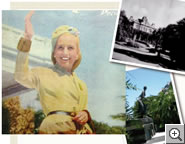 • La Residencia • La Residencia
Argentine presidents work in the Casa Rosada and live elsewhere. Until the military coup in 1955, presidents lived in “La Residencia,” donated to the nation by the Unzue family.
Because Perón and Evita had lived there since 1946 and Evita died there in 1952, the Residence was destroyed. The Fundación Eva Perón began in an unused garage on the grounds.
Unions began donating everything from sugar to shoes for those in need and Evita stored them there until she ran out of space. Years later the national library was built on the grounds. In its garden is a monument to Evita (she seems to be escaping) and a plaza dedicated to her.
• Recoleta Cemetery
 The Church dates from 1732, the cemetery from 1822. In the Duarte family mausoleum, Evita rests in peace, together with her mother, her brother Juan, and her sisters Blanca and Elisa. After years of exile hidden in a cemetery in Milan, Italy, Evita’s body was repatriated in 1974. Prayers, flowers and notes are left on the door of the mausoleum for her, often by the children and grandchildren of the people whose lives she touched. The Church dates from 1732, the cemetery from 1822. In the Duarte family mausoleum, Evita rests in peace, together with her mother, her brother Juan, and her sisters Blanca and Elisa. After years of exile hidden in a cemetery in Milan, Italy, Evita’s body was repatriated in 1974. Prayers, flowers and notes are left on the door of the mausoleum for her, often by the children and grandchildren of the people whose lives she touched.
• Calle Posadas 1567
Perón and Evita lived on the fourth floor before he was elected President in February of 1946. Here Perón initiated Evita into politics. She sat in on meetings with union leaders, military officers and politicians, refusing to be relegated to the role of serving coffee. Her presence and participation were highly unusual for the time and her frankness ruffled many feathers.
• Avenida Callao 1944
Juan Duarte, Evita’s brother, lived here after he became private secretary to President Perón He was extremely close to his sister and never recovered from her death. In April, 1953, his body was found in his bedroom, a bullet hole in his head. Exactly how he died remains a mystery.

Long an elegant neighborhood of tree shaded streets, imposing houses and fragrant gardens, Belgrano once had its moment of glory as the capital of the country. The tramway and the train opened up Belgrano to the porteños. Visitors are attracted to the “Redonda,” one Buenos Aires’ most beautiful churches, to its artisan markets and to its bustling Chinatown.
• Ciudad Infantil - Children's City / Mendoza & Dragones
 The apple of Evita’s eye, the Ciudad Infantil was a nursery school for children of working mothers and a home for 110 children whose parents could not care for them (450 in all). The miniature city that delighted thousands of children was torn down after the military coup in 1955 to make way for a parking lot (like destroying Disneyland because you don’t like Walt). The apple of Evita’s eye, the Ciudad Infantil was a nursery school for children of working mothers and a home for 110 children whose parents could not care for them (450 in all). The miniature city that delighted thousands of children was torn down after the military coup in 1955 to make way for a parking lot (like destroying Disneyland because you don’t like Walt).
What remains houses ALPI.
• La Ciudad Estudiantil / Studentsí City (now Incucai)
Students from low income families and scholarship students from abroad lived in the Students’ City, were bused to local high schools, tutored in the evenings, swam, played sports, and cogoverned the city together with their instructors. Everyone had a job to do, from welcoming newcomers to holding elective office. Students were given clothes, books, medical attention, and, as long as they passed their classes, entrance to the universities.
• Hospital Militar / Luis María Campos 726
Perón was taken here on October 17, 1945, after being released from prison. That night he left the Military Hospital to speak from the balcony of the Casa Rosada to his “descamisados” - men, women and children-who had gathered to demand his release from prison and were waiting for him in the Plaza de Mayo...a defining moment in Argentine history.

You can visit the Evita Museum in Los Toldos where Evita lived as a child, Junín where you can see her school and a house she lived in, and San Vicente, the country house where Perón and Evita relaxed. These places can be reached by car, train or bus.
 “Only by involving ourselves with sorrow, living and suffering with others, no matter what their color, creed or race, can we carry out the enormous task of constructing a world of justice that will lead us to peace. It is well worthwhile to burn up our lives in creating solidarity if the fruit will be peace and happiness in the world, although that fruit may not ripen until we ourselves have disappeared.” “Only by involving ourselves with sorrow, living and suffering with others, no matter what their color, creed or race, can we carry out the enormous task of constructing a world of justice that will lead us to peace. It is well worthwhile to burn up our lives in creating solidarity if the fruit will be peace and happiness in the world, although that fruit may not ripen until we ourselves have disappeared.”
• Los Toldos / 305 KMs / 190 Miles from Buenos Aires
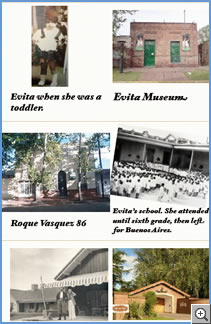 Evita was born on May 7, 1919, at La Unión, near the small town of Los Toldos and lived in Los Toldos as a young child. After her father’s death, her mother and older sisters sewed to support Evita and her four siblings: Elisa, Blanca, Juan and Erminda. The Evita Museum in Los Toldos is located at the corner of Eva Perón and Belgrano. Evita was born on May 7, 1919, at La Unión, near the small town of Los Toldos and lived in Los Toldos as a young child. After her father’s death, her mother and older sisters sewed to support Evita and her four siblings: Elisa, Blanca, Juan and Erminda. The Evita Museum in Los Toldos is located at the corner of Eva Perón and Belgrano.
Tel. 54 2358 442473
Museum hours:
Mon-Fri 10-12 & 14-18:30 ; Weekends from 10-19 hs.
• Junín / 260 KMs / 161 Miles from Buenos Aires
As a young teenager, Evita lived in Junín and attended school there. The house at Roque Vasquez 86 is the only house she lived in as child that has remained unchanged. On her way home from school, Evita liked to stop and recite poetry at a music shop with loud speakers set up to broadcast to the Plaza. She and her sister Blanca participated in plays put on by Erminda’s high school theater group.
• Quinta San Vicente / 72 KMs / 45 Miles from Buenos Aires
Perón bought this country house (quinta) from his friend Colonel Mercante. He improved it and during his time in office he and Evita spent weekends there. It is now a museum and Perón’s body rests in a mausoleum near the Quinta. The presidential railway car is preserved there as are beheaded statues rescued from the river where they were dumped after the military coup in 1955.

|
